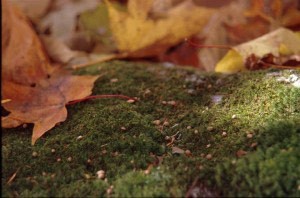
The results are in from a long-term study that has been measuring the response of sugar maples to calcium addition at the Hubbard Brook Experimental Forest in New Hampshire. They confirm scientists’ suspicions that depletion of soil calcium, which is due in large part to acid deposition, is a leading cause of sugar maple decline.
Combustion of fossil fuels loads the atmosphere with acids that fall to earth in snow, fog, or rain, resulting in acid deposition. The problem is particularly acute in the Northeast, where weather systems concentrate pollution emitted from power plants and vehicles in the West and Midwest. Acid deposition causes a host of problems, including acidification of waterways. Even worse, acids in rainwater leach base cations such as calcium, crucial to plant health and not quickly replaced, from the soil.
In 1999, scientists at Hubbard Brook, where sugar maple growth has declined over the past 25 years, set out to discover what would happen if enough calcium to emulate pre-industrial levels was added back into the equation. Pellets of calcium, in a mineral form known as wollastonite, were dropped over the entire watershed from a huge hopper attached to a helicopter. The scientists, led by a team from Cornell University, published their results in the May 2006 issue of Ecology.
Leaves of canopy sugar maples in the study area showed increased concentrations of calcium in just the second year after the wollastonite application. In the fourth and fifth years, leaf manganese concentrations declined, which is another positive result. (Acid rain increases soil manganese, which can be toxic to maples at high concentrations.) By the sixth year of the experiment, the crowns of study-area sugar maples were noticeably healthier than those in nearby, untreated areas.
The researchers also noted significantly more sugar maple seedlings in the treated study area in comparison with the reference, untreated area. They attribute this to either higher germination rates, better survival, or both; the seedlings from the treated area were consistently about a third more substantial than their untreated partners, and they had greater chlorophyll concentrations in their leaves.
Finally, the team discovered that colonization of sugar maple seedling roots by beneficial mycorrhizae (fungi that make soil nutrients readily available, thereby helping maples grow and thrive) was significantly greater in the treated area. Even the relationship of mature maples with their mychorrhizal partners was enhanced, though to a somewhat lesser degree.
This study strongly supports previous work demonstrating the link between acid deposition and tree decline (especially of sugar maples) throughout the Northeast, though the mechanism of decline is not fully understood. The authors suggest that calcium may ameliorate manganese or even aluminum toxicity, but they note that the complexity of the interactions between trees, soil mineral availability, and mycorrhizae precludes an easy answer.


Discussion *